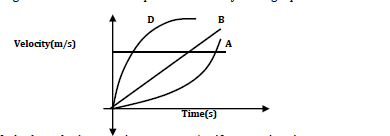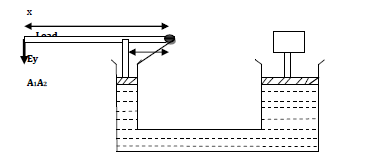a) When the lift is at rest.
This implies that the resultant force on the lift is zero i.e. action and reaction are equal in size. The force acting on the lift is the weight of the person standing in the lift. This is balanced by the reaction by the floor of the lift.
Therefore, weight mg=- reaction R,
Or simply; mg+R=0.
b) When the lift descends with an acceleration a
For the lift to move downwards, the weight of the occupant must be greater than the reaction by the floor of the lift. Therefore, the resultant force pulling the lift downwards is equal to the difference between the weight mg and the reaction R;
Resultant force F= mg-R.
From the second law of motion, the resultant force F=ma.
Therefore, ma=mg-R.
And R=mg-ma =m(g-a).
c) When the lift ascends with an acceleration a
In this case, the reaction by the floor of the lift must be greater than the weight of the occupant. Hence, the resultant force F=ma=R-mg.
And R=ma+mg=m(a+g).
sharon kalunda answered the question on April 24, 2019 at 06:21
- Highlight three practical examples where the Newton’s first law of motion is applied.(Solved)
Highlight three practical examples where the Newton’s first law of motion is applied.
Date posted: April 24, 2019. Answers (1)
- Describe an experiment to determine acceleration due to gravity.(Solved)
Describe an experiment to determine acceleration due to gravity.
Date posted: April 24, 2019. Answers (1)
- Describe horizontal projection.(Solved)
Describe horizontal projection.
Date posted: April 24, 2019. Answers (1)
- Describe vertical projection.(Solved)
Describe vertical projection.
Date posted: April 24, 2019. Answers (1)
- Describe free fall.(Solved)
Describe free fall.
Date posted: April 24, 2019. Answers (1)
- Using a tick-timer tape show the patterns for the following motions;
a)A body moving at constant velocity.
b)A body moving with increasing velocity (accelerating).
c)A body moving with...(Solved)
Using a tick-timer tape show the patterns for the following motions;
a)A body moving at constant velocity.
b)A body moving with increasing velocity (accelerating).
c)A body moving with decreasing velocity (decelerating).
In each case show the direction of motion.
Date posted: April 24, 2019. Answers (1)
- Describe the following Velocity-time graphs:(Solved)
Describe the following Velocity-time graphs:

Date posted: April 24, 2019. Answers (1)
- Explain the dangers of static charges(Solved)
Explain the dangers of static charges
Date posted: April 23, 2019. Answers (1)
- In the figure below x=30cm, y=6cm, effort E=60N, A1=4cm2 and A2=12cm2.(Solved)
In the figure below x=30cm, y=6cm, effort E=60N, A1=4cm2 and A2=12cm2.

Calculate:
a) The force F exerted on the liquid at A1.
b) The velocity ratio of the system.
c) The maximum load that can be raised by the system.
Date posted: April 23, 2019. Answers (1)
- A box of mass 30kg is pushed up an inclined plane of length 14m using a force of 130N as shown below:(Solved)
A box of mass 30kg is pushed up an inclined plane of length 14m using a force of 130N as shown below:

If the track is inclined at an angle of 200, calculate:
a) The height of the platform.
b) Workdone by the force of 130N.
Date posted: April 23, 2019. Answers (1)
- Draw a flow chart to show the energy transformation in a hydroelectric power station:(Solved)
Draw a flow chart to show the energy transformation in a hydroelectric power station:
Date posted: April 23, 2019. Answers (1)
- State the characteristics energy:(Solved)
State the characteristics energy:
Date posted: April 23, 2019. Answers (1)
- The mass of a density bottle is 20g when empty and 45g when full of water. When full of mercury, its mass is 360g. Calculate...(Solved)
The mass of a density bottle is 20g when empty and 45g when full of water. When full of mercury, its mass is 360g. Calculate the density of mercury.
Date posted: April 23, 2019. Answers (1)
- Derive the three equations of linear motion.(Solved)
Derive the three equations of linear motion.
Date posted: April 23, 2019. Answers (1)
- The figure below represents part of a tape pulled through a ticker-timer by a trolley moving down an inclined plane. If the frequency of the...(Solved)
The figure below represents part of a tape pulled through a ticker-timer by a trolley moving down an inclined plane. If the frequency of the ticker-timer is 50Hz, calculate the acceleration of the trolley.

Date posted: April 23, 2019. Answers (1)
- A paper tape was attached to a moving trolley and allowed to run through a ticker-timer. The figure below shows a section of the tape.(Solved)
A paper tape was attached to a moving trolley and allowed to run through a ticker-timer. The figure below shows a section of the tape.

If the frequency of the ticker-timer is 20Hz, determine:
a) The velocity between AB and CD.
b) The acceleration of the trolley.
Date posted: April 23, 2019. Answers (1)
- A body is made to change its velocity from 20m/s to 36m/s in 0.1s. What is the acceleration produced?(Solved)
A body is made to change its velocity from 20m/s to 36m/s in 0.1s. What is the acceleration produced?
Date posted: April 23, 2019. Answers (1)
- Outline the three common types of motion:(Solved)
Outline the three common types of motion:
Date posted: April 23, 2019. Answers (1)
- A machine with a velocity ratio of 30 moves a load of 300N when an effort of 200N is applied. Calculate the efficiency of the...(Solved)
A machine with a velocity ratio of 30 moves a load of 300N when an effort of 200N is applied. Calculate the efficiency of the machine.
Date posted: April 22, 2019. Answers (1)
- Explain why a man using a parachute falls through air slowly while a stone falls through air very fast(Solved)
Explain why a man using a parachute falls through air slowly while a stone falls through air very fast.
Date posted: April 22, 2019. Answers (1)